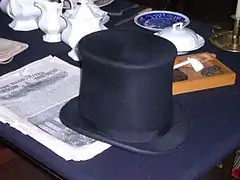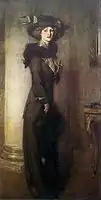Beaver hat
A beaver hat is a hat made from felted beaver fur. They were fashionable across much of Europe during the period 1550–1850 because the soft yet resilient material could be easily combed to make a variety of hat shapes (including the familiar top hat).[1] Smaller hats made of beaver were sometimes called beaverkins,[2] as in Thomas Carlyle's description of his wife as a child.[3]

Used winter coats worn by Native Americans were actually a prized commodity for hat making because their wear helped prepare the skins; separating out the coarser hairs from the pelts. [4]
To make felt, the underhairs were shaved from the beaver pelt and mixed with a vibrating hatter's bow. The matted fabric was pummeled and boiled repeatedly, resulting in a shrunken and thickened felt. Filled over a hat-form block, the felt was pressed and steamed into shape. The hat maker then brushed the outside surface to a sheen.[5]
Evidence of felted beaver hats in western Europe can be found in Chaucer's Canterbury Tales, written in the late 14th century: "A Merchant was there with a forked beard / In motley, and high on his horse he sat, / Upon his head a Flandrish [Flemish] beaver hat."[6] Demand for beaver fur led to the near-extinction of the Eurasian beaver and the North American beaver in succession. It seems likely that only a sudden change in style saved the beaver.[7]
Beaver hats were made in various styles as a matter of civil status:
- the Wellington (1820–40)
- the Paris beau (1815)
- the D'Orsay (1820)
- the Regent (1825)
- the clerical (18th century).
In addition, beaver hats were made in various styles as a matter of military status:
- the continental cocked hat (1776)
- Navy cocked hat (19th century)
- the Army shako (1837).[8]
The popularity of the beaver hat declined in the early/mid-19th century as silk hats became more fashionable across Europe.
- Examples
 A silk reproduction felt hat, Lower Fort Garry NHS.
A silk reproduction felt hat, Lower Fort Garry NHS. Shapes and styles of beaver hat 1776–1825
Shapes and styles of beaver hat 1776–1825 19th century Masonic Knights Templar Beaver Fur hat
19th century Masonic Knights Templar Beaver Fur hat English military engineer John By (1779-1836)
English military engineer John By (1779-1836) Edward Arthur Walton – The Beaver Hat
Edward Arthur Walton – The Beaver Hat
References
- Wallace-Wells, D. "Puritan Inc." The New Republic, 2010.
- Picken, Mary Brooks (1999). A dictionary of costume and fashion : historic and modern : with over 950 illustrations. Courier Dover Publications. p. 160. ISBN 9780486141602.
- Carlyle, Thomas (2012) [1881]. Froude, James Anthony (ed.). Reminscences. Cambridge University Press. ISBN 9781108044790.
...dainty little cap, perhaps little beaverkin (with flap turned up)...
- Hämäläinen, Pekka, 1967- (2019-10-22). Lakota America : a new history of indigenous power. New Haven. ISBN 978-0-300-21595-3. OCLC 1089959340.CS1 maint: multiple names: authors list (link)
- Brigham, Walter. "Baltimore Hats".
- Chaucer, Geoffrey (1392). The Canterbury Tales and other poems. ISBN 978-1499629361.
- "The Role of Beaver in the European Fur Trade", accessed 2019.07.26.
- Gray, Charlotte (2004). The Museum Called Canada: 25 Rooms of Wonder. Random House.
External links
![]() Media related to Beaver hats at Wikimedia Commons
Media related to Beaver hats at Wikimedia Commons